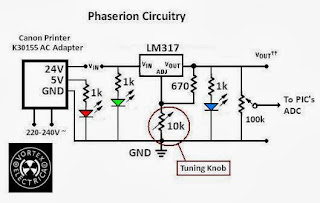Assalamu'alaikum everyone,
It has been a slow year for all of us are busier than ever. However, we're still burning with project ideas. On my side, I have just setup my small working area and I have been using the Phaserion & Variator for three years. (It has been that long? Whoa!).
This time, I'm going to provide some updates on Phaserion, which I think is a very handy equipment I have built all these years. It is an adjustable power supply with a range of 1.5-22V, and I have been using it for just about everything for my electronics projects.
This is a video of the addition I made for the Phaserion:
Variator with a shiny new display
The feature addition on the Phaserion is pretty important- I added a 7-segment display to indicate the voltage, which is helpful if you have various projects with different supply requirements. The PIC used was the ever-so-simple PIC16F876 (Which I first bought after looking into Nigel's tutorials) and I think it is high time it is permanently embedded into a proper application gizmo for all that I've learnt from Microchip's PICs. We'll have a small tutorial on the 7-segment later, in which the programming was done using MikroC. (I don't think I could have progressed well in my programming if I'm stuck to Assembly language. No hard feelings there Uncle Nigel.). Here's the additional circuit:
A bit of a stumbling block here- How do I detect 22V when PIC is capable only up to around 5V? The answer is simple: A trimpot. Install a trimmer between the output power, and let it swing to it's maximum output. After doing so, slowly tune your pot to give a 5V output. Therefore the output is now 22V Ξ 5V. Swing your voltage down. It will rescale to a lower voltage!
A bit of a stumbling block here- How do I detect 22V when PIC is capable only up to around 5V? The answer is simple: A trimpot. Install a trimmer between the output power, and let it swing to it's maximum output. After doing so, slowly tune your pot to give a 5V output. Therefore the output is now 22V Ξ 5V. Swing your voltage down. It will rescale to a lower voltage!
Some of the pictures may speak a squillion words:
You can see that black-and-white trimmer/trimpot (bought when I was shopping with Beautifulmind seven years ago, you know!) for scaling down 22V maximum swing to a 5V maximum swing... that'll be for the PIC.
Phaserion adapted for my Starke drill batteries' charging
...and it can be used for my breadboard supply
...Yup. I used my old Chinese multimeter terminals for an in-situ power supply (good for testing nook-in-the-crannies)
Adapted for crocodile clips as well (Just for show dudes)
And since we have so many cables, a good way to organize them would be to use small cardboard cylinders to store 'em cables. Trust me, a good working space is a TIDY one.
So that's all for this article. The circuit addition is pretty simple but we'll cover that later in more detail when the 7-segment tutorial is done.
Keep on Vortexifying everyone!
Regards,
Vizier87.









Nice DIY project! hope to see more.
ReplyDeletethanks!
ReplyDelete